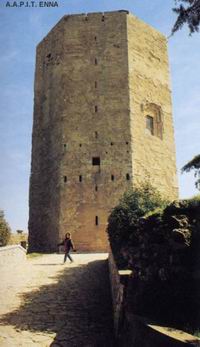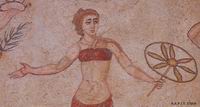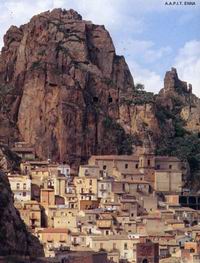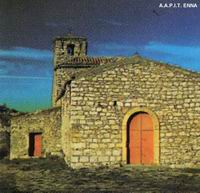|
Our history is written by several hands and this has contributed to forge our present day reality.
Great civilisations rose and died out, each one leaving their souls and written evidence on the stones of Sicily. Today, this is our more certain treasure, like the thread of Ariadne that connects past and future.
The province of Enna is a piece of everything which makes Sicily unique: myths, legends, but also history, traditions, remains of a pompous past, a unique and mostly uncontaminated environment and the warm welcome of local people. In Enna and around its province, it is still possible to walk around the woods, discovering new places and reflecting yourself in mountain ponds. You can read the history directly where it has been written, admire ageless archaeological finds, taste genuine recipes and participate in the numerous events organised during the year.
All this contributes to create a unique tourist offer.
 Enna, the chief town, is known for the Castle of Lombardy, excellently preserved, that, during the centuries suffered several improvements and that owes its current set-up to Frederick II of Swabia. Of great historical interest is the Tower of Frederick. Enna, the chief town, is known for the Castle of Lombardy, excellently preserved, that, during the centuries suffered several improvements and that owes its current set-up to Frederick II of Swabia. Of great historical interest is the Tower of Frederick.
This has an octagonal shape and is situated in the middle of a verdant garden surrounded, in the past, by a wall of the same shape. A synthesis of many centuries of art and culture is offered by the Cathedral, in whose structure we find Gothic-Catalan, Renaissance and Baroque influences. The two museums are also interesting: the Alessi Museum, with documents of great historical importance and artistic value, which embrace an arc of time from prehistory until our days and the Varisano Museum, that guards in its five ample rooms fascinating finds relating to the life of native people during the hellenisation of the territory.
NATURAL ITINERARIES
The province of Enna, the only one in Sicily that does not touch the sea, with its natural, historical and cultural patrimony offers a wide panorama of uncontaminated places. The tormented orography, the numerous lakes (among eight of them, only Pergusa is natural), and the woods constitute a variegated scenery of great attraction to tourists. The lakes Ancipa and Nicoletti, for example, are the destinations of fishermen and people who love water skiing. We can also add the suggestions of the farming civilisation (the province, during its glorious past, was known, by the Romans, as the “barn of the empire”) that in Enna translate into a natural sense of welcoming, and a delicious cuisine that values its best products, like dry and fresh broad beans, the “late fishing” of Leonforte and others precious resources of the district.
ARCHAEOLOGICAL ITINERARIES
”From Italy, where they lived, the Siculis escaping the Opicis, passed to Sicily by boat... They defeated the Sikanis in battle, who were thereby confined to the southern and western regions, and called the Sikan island Sikelia. Having completed the journey, they occupied the most fertile areas of the country, around 300 years before the Greeks set foot on the island, and still now they are in the center and north of the island”. This is how Theucidides introduces us to one of the crucial moments of the ancient history of Sicily, with particular reference to the interior situation of the island.
The migratory flow, which occurred around the year 100 b.C, saw the participation of the other ethnic groups; the Morgetis, led by the legendary Morges, settled in the center of the island, founding the city of Morgantina, as Strabone tells us.
The most precious testimonies of the rich past of Enna and its surroundings are kept in the museums of the area. Among these, there is the Alessi Museum (in Enna) with finds and prints belonging to the rector Giuseppe Alessi. Note also the Varisano Museum, again in Enna, with the five rooms of the Archaeological Regional Museum, the Museum of Aidone, situated near the ancient Convent of the Cappuccini (17th century); the Civic Museum of Centuripe with the Archaeological Collection, the archaeological Museum of Sperlinga and the Museum of mining art and farming civilisation, in Villarosa.
The prehistoric and proto-historic period is testified by numerous settlements that occupied in a capillary way the whole territory of the province of Enna; the particular geophysical conformation, rich in caves, fertile ground and water, was sufficiently functional for the type of life conducted by its first people. Besides, its central position gave the possibility to be constantly crossed by the main cultural flows. The meeting with the Greek social-economic system, produced, from the end of the 7th / beginning of the 6th centuries b.C, notable changes in the social and urban organisation of these populations; the demand to live in places that answer to defensive criteria and at the same time function for commerce, was more pressing. All the mountains became occupied by stable settlements that follow the same building criteria. The urban characteristics of the hinterland villages mark a common way to see and live in towns. Numerous testimonies of these circumstances remain in the area, where an archaeological itinerary allows the reliving of fascinating centuries of history. It concerns sites rich in traces of the past, but not always sufficiently known. In fact, if we know the Roman Villa of Piazza Armerina and Morgantina, 4 kilometres from Aidone, we can not say the same for other areas, which are equally important.
THE ROMAN VILLA OF PIAZZA ARMERINA: undoubtedly, a stop in Sicily can not put aside a visit to the Roman Villa, an asymmetrical complex, but functionally unitary, whose construction surely required a long time, as is deducible from its complexity and greatness and from the ample surface. It is in fact around 1,000 square meters and for the variety of themes, plasticity, elegance and the form of the images makes one think of the hand of master craftsmen. Built in terraces to follow the course of the ground, the monument includes, organised on three different levels: thermal baths, guests rooms, the rooms of the owner and his family and a vast dining room. The villa, which was declared by UNESCO a world heritage site, symbolises the use of the countryside as a center of power and a base of the rural economy of the Western Empire during the Roman period. . According to the typology of the 4th century a.D, the Roman Villa is one of the most luxurious monumental examples: the mosaics, found almost in every room, are the most beautiful existing ones of the Romane age. According to the typology of the 4th century a.D, the Roman Villa is one of the most luxurious monumental examples: the mosaics, found almost in every room, are the most beautiful existing ones of the Romane age.
MORGANTINA
14 kilometres from Piazza Armerina and near Aidone, there is Morgantina. Discovered in 1955 thanks to the University of Princeton, it is the most important archaeological discovery made in Sicily in the 20th century. The town, abandoned around 36 b.C, covered by a substantial layer of dust and ash, reached us as it was at the time of Geron II, halfway through the 3rd century b.C. Its urban center is characterised by a road network constituted by a main artery from where other perpendicular streets depart. The inhabited area had a water complex with a cistern and a canalisation system fed by large reservoirs. The finds deriving from the excavations effected in the ancient city are exhibited in the Regional Archaeological Museum in the ex Convent of the Cappuccini.
THE NECROPOLISES OF ROSSOMANNO
Between Piazza Armerina and Valguarnera there is Rossomanno, a famous place for its necropolises of Rocca Crovacchio, that preserves in Sierra Casazze traces of the inhabited area of archaic age and, on the summit of Castellazzo, a construction of the mediaeval age.
MONTAGNA DI MARZO
Between Piazza Armerina and Barrafranca there is Montagna di Marzo, a site where there are city walls of the 5th century, which present an entrance door and a tower.
COZZO MATRICE
Taking a “trazzera” from the “Pergusina”, a road that connects Enna to Piazza Armerina, we arrive at Cozzo Matrice, where the remains of a workshop of the late copper age and a rocky necropolis with graves dug in the rock, have been discovered. An archaic building is also set near the same necropolis.
CAVES AND NECROPOLIS
In the slopes of Enna, finally, there are numerous caves, for which it is not easy to establish a chronology, but that must have been residences or funeral sites. At the southern entrace of the town, there is the Cave of Spezeria, which deserves particular attention. It is characterised by numerous cells dug in the wall for the deposition of votive  statuettes. The area around Calascibetta is of notable interest, where four rocky necropolises of the 3rd-2nd millennium b.C have been explored. The most ancient is that of Malpasso: five graves with several rooms have returned red monochrome ceramics, allowing the extension of the facies of Malpasso to the recoveries in other Sicilian sites of the same type of china. The most famous is the Realmese Necropolis, with its 300 graves. Used from the middle of the 9th century b.C (Final bronze-first iron ages) up to the second quarter of the 6th century b.C, introduces the particularity of the cohabitation ot two different cultural phases. The several pre-Hellenistic sepulchral rooms, recently open in Pietraperzia, are interesting. A necropolis with graves and objects that indicate settlements of prehistory up to the Roman period was recently discovered in Assoro. statuettes. The area around Calascibetta is of notable interest, where four rocky necropolises of the 3rd-2nd millennium b.C have been explored. The most ancient is that of Malpasso: five graves with several rooms have returned red monochrome ceramics, allowing the extension of the facies of Malpasso to the recoveries in other Sicilian sites of the same type of china. The most famous is the Realmese Necropolis, with its 300 graves. Used from the middle of the 9th century b.C (Final bronze-first iron ages) up to the second quarter of the 6th century b.C, introduces the particularity of the cohabitation ot two different cultural phases. The several pre-Hellenistic sepulchral rooms, recently open in Pietraperzia, are interesting. A necropolis with graves and objects that indicate settlements of prehistory up to the Roman period was recently discovered in Assoro.
TROINA AND CENTURIPE OF ROMANE AGE
In Troina, the most important archaeological area is in the area of Catena where, besides several Hellenistic remains, sections of the urban area, including housing structures with Roman thermal fittings have been discovered. In Centuripe, in the same area of the city, there are the remains of Roman baths of imperial epoch on Mount Galvano and those of a Hellenistic house and an ancient building denominated “La Dogana”, on Mount Porcello. The building of the Augustali deserves particular attention.
THE BEAUTY OF THE STONES
”...What makes Sicily and essential land, unique in the world, is the fact that it is, from one end to the other, a strange and divine museum of architecture. Architecture has died in this century. It still has the taste of the arts today but it seems to have lost the gift of creating beauty through stones, the mysterious secret of seduction through lines and the sense of grace in the monuments”. This is how Guy de Maupassant writes in his book “La Sicilia”.
The province of Enna is characterised by a rich castle architecture but also by the presence of numerous strengthened suburbs of which today only a few vestiges survive, often not easy to “read”.
Our itinerary includes the castles that have better preserved parts of their own shape, constituting today the best testimony of a different way of designing architecture, in harmony and almost in symbiosis with the ground and the surrounding nature. We suggest a fantastic itinerary through the beauty of nature, in a varied landscape, visiting the Castles.
RELIGIOUS AND FOLKLORISTIC FESTIVALS
Rich in natural beauty, a rare artistic patrimony and interesting archaeological areas, the Province of Enna is also a custodian of traditions. These traditions reveal a complex substratum deriving from several cultures diffuses throughout the island during different periods of foreign domination, each of which has contributed to the civilisation. In the numerous traditions there are different connotations connected with both pre-Christian and Christian culture, especially the various Norman and Spanish aspects. Thus, the custom of a city and of a people to have a divinity as protection is indeed ancient. A custom that, as Pitrè says “was born from the desire for protection and guardianship, from the humanity”. Initially human beings, sacrificing in the temple, would address the gods in oder to have favours. With the advent of Christianity, people would address the Saints, the Madonna and the Crucifix. Today the province has a lively cultural activities organised by local Institutions and Associations.
We thanks Autonomous Provincial Agency for Tourism's Increase of Enna, that is texts and photos owner
|



 Munch: The Scream Within
Munch: The Scream Within In the garden
In the garden Perugia Travel Guide
Perugia Travel Guide


 Enna, the chief town, is known for the Castle of Lombardy, excellently preserved, that, during the centuries suffered several improvements and that owes its current set-up to Frederick II of Swabia. Of great historical interest is the Tower of Frederick.
Enna, the chief town, is known for the Castle of Lombardy, excellently preserved, that, during the centuries suffered several improvements and that owes its current set-up to Frederick II of Swabia. Of great historical interest is the Tower of Frederick.
 According to the typology of the 4th century a.D, the Roman Villa is one of the most luxurious monumental examples: the mosaics, found almost in every room, are the most beautiful existing ones of the Romane age.
According to the typology of the 4th century a.D, the Roman Villa is one of the most luxurious monumental examples: the mosaics, found almost in every room, are the most beautiful existing ones of the Romane age. statuettes. The area around Calascibetta is of notable interest, where four rocky necropolises of the 3rd-2nd millennium b.C have been explored. The most ancient is that of Malpasso: five graves with several rooms have returned red monochrome ceramics, allowing the extension of the facies of Malpasso to the recoveries in other Sicilian sites of the same type of china. The most famous is the Realmese Necropolis, with its 300 graves. Used from the middle of the 9th century b.C (Final bronze-first iron ages) up to the second quarter of the 6th century b.C, introduces the particularity of the cohabitation ot two different cultural phases. The several pre-Hellenistic sepulchral rooms, recently open in Pietraperzia, are interesting. A necropolis with graves and objects that indicate settlements of prehistory up to the Roman period was recently discovered in Assoro.
statuettes. The area around Calascibetta is of notable interest, where four rocky necropolises of the 3rd-2nd millennium b.C have been explored. The most ancient is that of Malpasso: five graves with several rooms have returned red monochrome ceramics, allowing the extension of the facies of Malpasso to the recoveries in other Sicilian sites of the same type of china. The most famous is the Realmese Necropolis, with its 300 graves. Used from the middle of the 9th century b.C (Final bronze-first iron ages) up to the second quarter of the 6th century b.C, introduces the particularity of the cohabitation ot two different cultural phases. The several pre-Hellenistic sepulchral rooms, recently open in Pietraperzia, are interesting. A necropolis with graves and objects that indicate settlements of prehistory up to the Roman period was recently discovered in Assoro.